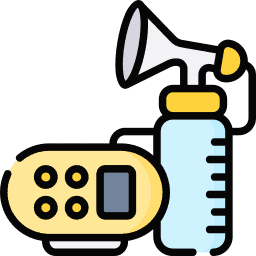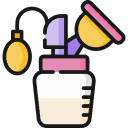Breastfeeding is the most natural thing in the world … until you try to do it in real life! From getting your newborn to latch to dealing with sore nipples to trying to pump enough milk, it can feel impossible at times. We’ve all been there.
If you’re struggling with low milk supply, power pumping is one trick that is worth trying. Figuring out how to power pump is simple, and it’s a strategy that has worked for many moms.
Looking to increase breast milk naturally? Let’s get the experts’ take on power pumping.
Key Takeaways
- Power pumping helps increase breast milk supply by stimulating more frequent feedings.
- Choose a convenient time to power pump, and experiment with different schedules to find what works best for you.
- Use a comfortable breast pump and try various techniques, such as manual massage and compression, to boost milk production.
- Monitor your baby’s growth and diaper output to ensure they are getting enough milk, and consult a doctor if needed.
What Is Power Pumping?
Before we talk milk, let’s dig a bit deeper into the science of breastmilk production. To understand the theory of power-pumping, it’s essential to look at what stimulates your body to make more milk.
Did you know that breast milk production comes down to supply and demand (1)? In most cases, our bodies will produce more milk when our babies drink more milk. Like a smart inventory manager, your body is always trying to keep up with demand!
Power pumping (or cluster pumping, as it’s sometimes called) works to boost production. Rather than doing one long feeding every few hours, power pumping is about smaller, more frequent feedings.
Since everybody is different and we all have our own unique schedule, there is no one-size-fits-all solution. Different moms respond differently to each breastfeeding technique.
So, how do you know if power pumping is right for you? Here are a few clues that you might want to learn how to cluster pump.
Should You Try Power Pumping?
If your milk production is low, it’s time to take stock. It’s all too easy to panic and decide that you’re not producing enough milk. Before you jump to any conclusions, let’s look at some of the most common questions and issues.
We often get asked: Is it normal for milk supply to decrease over time? Why has my breast milk decreased suddenly? Is my milk supply drying up?
Before you decide that you’re not producing enough breast milk, look to your baby. If your little one is regularly producing wet and dirty diapers, there may not be an issue at all.
What The Doctors Say
A key indicator of proper nutrition is your baby’s growth. From birth to six months of age, your baby should be gaining around 140 to 200 grams of weight per week.
Every month, a baby six months and under will grow about half an inch to one inch. For babies between six months and one year, you will see about one centimeter of growth a month. During this same time, you should see weight gains around five to seven ounces (2).
If your pediatrician is happy with your baby’s growth and you are regularly changing diapers, you’re doing it all right! However, if you are having trouble producing milk, you might want to learn how to power pump.
The best thing about power pumping is that it allows you to produce more breast milk naturally. There are no supplements or medication required, which we always love to hear. All you need to do is adjust your breastfeeding schedule and see what works for you.
How to Power Pump
Ready to increase your breast milk production naturally? It’s time to power the pump! You’ll see different cluster pumping schedules and routines, so experiment until you find what works before for you.
Here is one of the most common methods of breastfeeding to increase milk:
- Choose one time each day when you can spend an hour breastfeeding. Most women produce more milk in the morning so aim for an early time if you can.
- Get started by pumping for 20 minutes.
- Rest for ten minutes.
- Pump again for ten minutes.
- Rest again for ten minutes.
- Pump one more time for ten minutes.
Stick with the same schedule for about a month or until you notice an increase in production. Many women find that it only takes a few days to boost milk production. Others need to wait a few weeks.
Mom Tip
The best time to pump is when you’re free. Avoid getting too bogged down by trying to find the time when you’re producing the most milk. If mornings are too hectic, plan to sit down every evening at the same time before bed.
Power Pumping Schedule
Every woman’s body is different, so play around with what works for you. While you might feel overwhelmed trying to figure out how to breastfeed successfully, listen to your body.
Lactation experts recommend four different schedule types to help moms find the best method for their bodies and lifestyle (3). Here are a few options to consider.
| – | 6 Sessions/Day | 2 Sessions/Day | 1 Session/Day | 1 Session/Day |
| Pump | 5 minutes | 10 minutes | 20 minutes | 15 minutes |
| Break | 5 minutes | 10 minutes | 10 minutes | 10 minutes |
| Pump | 5 minutes | 10 minutes | 10 minutes | 15 minutes |
| Break | 5 minutes | 10 minutes | 10 minutes | 10 minutes |
| Pump | 5 minutes | 10 minutes | 10 minutes | 15 minutes |
Power Pumping FAQs
Are you ready to start power pumping? Let’s look at some of the most frequently asked questions on increasing milk production and making cluster feeding work for you.
More Ways to Increase Milk Supply
The US Office on Women’s Health recommends a range of ways to increase milk supply with or without power pumping (6). Here are a few helpful hints that you can use to try to boost your breast milk.
- Breast massages and compression: When you’re pumping, manual massage can make a major difference in breast milk output.
- Mix things up: When nursing, avoid favoring one breast. Offer both to your baby, and you might find one side offering more milk than the other.
- Utilize your breast pump: When nursing a tired baby who doesn’t drink all of the milk, use a breast pump to fully empty your breasts. While it takes a while to get used to the feeling, you will know your breasts are empty because they’ll soften.
- Breastfeed ASAP: Make it a point to start breastfeeding or pumping as soon as you possibly can after giving birth. This will make a big difference in future milk production.
- Stick with it: Okay, I know this is a real challenge but try to breastfeed every two to three hours each and every day.
- Listen to your baby: Healthy babies will start to create their own feeding patterns. Pay attention and don’t stress over each session.
To Power Pump or Not to Power Pump
Are you thinking about power pumping? For many moms, this is the breastfeeding technique that makes all of the difference. If you are having a hard time with milk production, this is an option that is well worth considering.
And, try to relax! That’s not always our strong suit as moms, but it helps us and our little ones. If your baby is growing big and strong, you are producing plenty of milk.











